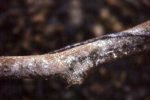Downy mildew on lettuce
Downy mildew is a serious problem in greenhouses especially under cold humid conditions. It is caused by the casual organism Bremia lactucae. Of the commercial crops, lettuce is most affected, but is also prominent with Endive, Escarole, Chicory, Salsify and Globe Artichoke. The fungus grows very fast and when the symptoms appear on the leaves, a reduction in total yields has already occurred. The outer leaves are affected first so some trimming can be done, however, the disease can spread during transport and render the crop unmarketable. There are numerous effective sprays that can be used. There are at least five physiologic races with selective pathogenicity on lettuce varieties and all are closely related to the Lactuca species.
The sporangia of Downy mildew germinate between 1°C and 19°C with optimum germination at 10°C. The tiny spores enter the leaf via the stomata. High humidity and cool weather are pre-requisites for germination and spread of the sporangia.
Symptoms of Downy mildew
The first signs are light green spots on the upper side of the leaves followed by yellowing between the veins. As soon as yellowing occurs the white mildew will be clearly visible on the underside of the leaves. Leaves lose their ability to photosynthesise and die quickly if not sprayed. The flavour is affected. Lettuce heads become unmarketable due to the unsightly appearance of the infected areas. If young lettuce plants become infected, they tend to stay small and die quickly.
Controlling Downy mildew
There are numerous chemicals that control downy mildew.



